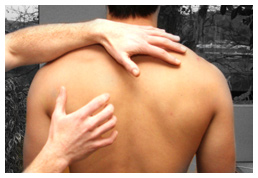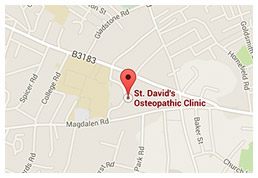Frequently Asked Questions
- How long do osteopathic appointments usually last?
-
In general, the first treatment lasts about 40-60 minutes, and subsequent treatments 40 minutes. Your first appointment is usually slightly longer to allow for a full case history to be taken.
- How much does treatment cost?
-
Treatment costs at Okehampton are £45 for new patients and £40 for a follow up.
Treatment costs at Exeter are £50 for new patients and £47 for a follow up.
- Can I see an osteopath through the NHS?
-
Currently, access to osteopathy in Devon on the NHS is limited, but services are becoming more widespread as commissioning authorities recognise the benefits of providing osteopathy to patients. To find out if NHS treatment is available in your area, speak to your GP and/or contact your local primary care trust.
There is more information on who to contact in your region on the NHS website
- Can I claim on my private medical insurance?
-
Many private health insurance policies provide cover for osteopathic treatment. It may be possible to claim for a course of treatment but you should check in advance with your insurance company before seeking osteopathic treatment, in order to confirm the available level of cover and whether you will need to have a referral from your GP or a specialist.
David is registered with Aviva, Bupa, Axa ppp, Simply Health, Pru Health, CIGNA and WPA.
- What do osteopaths treat?
-
Osteopathy focuses on the diagnosis, management, treatment and prevention of musculoskeletal and other related disorders without the use of drugs or surgery. Commonly treated conditions include back and neck pain, postural problems, sporting injuries, muscle and joint deterioration, restricted mobility and occupational ill-health.
- Do I need a GP referral to see an osteopath?
-
Most patients 'self refer' to an osteopath for treatment. Although referral by a GP is not necessary, patients are encouraged to keep both their GP and osteopath fully informed, so that their medical records are current and complete and the patient receives the best possible care from both healthcare practitioners.
- Do GPs refer their patients to osteopaths?
-
Yes. GPs refer patients to osteopaths where they believe this intervention would be beneficial. Referral guidelines are provided by the General Medical Council and British Medical Association.
- Can osteopathy treat Arthritis?
-
Arthritis is a very common condition which osteopathy is suitable for. Although arthritis is a non-reversible degenerative condition, many of the compensatory and pain relieving postural adaptations to it are entirely reversible. This frequently eliminates all the symptoms, however the underlying arthritic changes remain.
- Are there any side effects from osteopathic treatment?
-
Following your first session of osteopathy you can expect to feel stiff and sore for up to 48 hours. This is similar to the feeling after too much unaccustomed exercise. When very long term problems are released, soreness and stiffness are also common. Following most treatments you will not be in pain, but will probably feel more tired/relaxed than normal. Drink plenty of water and go to bed early. If after a treatment you are in a degree of pain you or your osteopath didn't expect, phone to discuss it, there is usually a very straightforward explanation.
- Can I have osteopathy if I am pregnant?
-
Yes, osteopathy is suitable for woman during pregnancy and entirely safe.
- What to wear?
-
You will need to undress to your underwear to enable the osteopath to assess and treat your back. If you are uncomfortable with this, please wear clothing such as shorts and a vest top that you will feel comfortable in. You are most welcome to bring a chaperone should you wish.
- What is the difference between an Osteopath and a Chiropractor?
-
Rather than focusing on the individual parts of the body, Osteopaths and Chiropractors view the body as a whole, a self-contained, self-healing, fully interconnected unit. The first supporter of this philosophy, Andrew Taylor Still, founded Osteopathy in America in 1874. Twenty-one years later, a former student of Dr. Still, Daniel David Palmer, founded the Chiropractic discipline
Osteopaths use soft tissue techniques (massage), articulation (passive movement of the limbs) and manipulations (thrust techniques). These are the main techniques along with muscle energy technique, visceral (organs) manipulation and cranial osteopathy.
Typically, sessions may last from 30-45 minutes and include a variety of treatment techniques.
Chiropractors work very similarly though concentrate more direct (thrust techniques) on the spine and less time on the muscles. Also they use ‘drop tables’ and Xray for diagnosis.
Chiropractic treatment sessions tend to be shorter, in the region of 15-20 minutes and more frequent than osteopathy.


